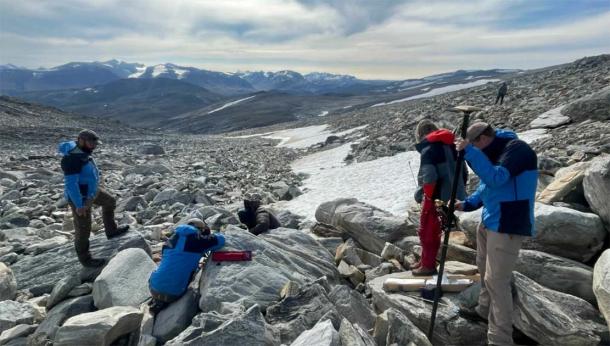
Ancient Horse Bridle Emerges from Melting Ice Along Viking Trade Route
A rare Viking Age artifact has melted from its icy-mountain tomb after 1,200 years. Discovered at 2,000 meters above sea level, this timeworn horse bridle whispers of ancient high-altitude traders and travelers, as well as of the animals that did the heavy work.

The horse bridle was discovered during an expedition to a smaller snow patch south of Lendbreen in Norway. (Espen Finstad / Secrets of The Ice / Innlandet County Municipality)
The “Exhilarating” Story of the Horse Bridle and Glacial Archaeology
Glacial archaeology is an exhilarating pursuit, uncovering ancient artifacts from ice-bound sites amidst vast high mountain terrain. The search begins with analyzing maps, aerial photos and satellite imagery to identify non-moving ice patches.
- Rapidly Melting Norwegian Ice Exposes Land Littered with Ancient Arrows
- Surprises from the Ice: Ancient Arrowheads Found Via Melting Glaciers in Norway
By integrating computer programs and local knowledge from mountain hikers, reindeer shepherds and wildlife researchers, archaeologists chart potential ancient travel routes across these icy landscapes, blending technology and exploration in their quest for ice-entombed artifacts.
Galdhøpiggen, the highest mountain in both Norway and Northern Europe, has presented an intriguing opportunity for archaeological exploration in its challenging alpine environment. Now, on a small snowy patch to the south of Lendbreen, near Galdhøpiggen, archaeologists have discovered a metal horse bridle and parts from a leather strap, which serve collectively as evidence of horse travel during the Viking Age.

Archaeologists are particularly excited by the well-preserved state of the horse bridle whose leather straps were still connected. (Espen Finstad / Secrets of The Ice / Innlandet County Municipality)
Horse Bridle Helps Track High-Altitude Viking Age Horses
Secrets of the Ice is an archaeological protection program managed by Innlandet County Municipality and the Museum of Cultural History at the University of Oslo. In an article on Sciencenorway.no, Espen Finstad, a glacial archaeologist at Innlandet County Municipality, said “the design of the horse bridle suggests it was made and used during the Viking Age,” roughly the late eighth century to the early 11th century.
What Finstad finds “particularly surprising” is that the horse bridle was found almost 2,000 meters [6,561 feet] above sea level. Providing reason for this high-altitude equestrian anomaly, Finsted said the discovery site confirms that the Lomseggen mountain pass was used for trade and travel during the Viking Age.
Over the last decade, melting snow and ice have uncovered hundreds of ancient artifacts in this part of Norway. Thanks to these remains appearing out of the snow, it is now known that the Lomseggen mountain pass was used by ancient Norwegians for over 1,200 years, claimed forskning.no.
We just made an incredibly discovery on the south side of the Lendbreen pass: An iron horse bit, with parts of the leather bridle preserved!❤️ It could well be from the Viking Age, when traffic through the pass was at its peak. But let's see what the radiocarbon date says. pic.twitter.com/cIRNXsZD9Y
— Secrets Of The Ice (@brearkeologi) September 7, 2023
Horse Bridle Presents a Fusion of Viking-Age Art and Utility
The discovery of the ancient horse bridle and other horse equipment demonstrates that the ancient trade route was not only walked upon by Viking traders, pilgrims and warriors, but it was also navigated by their four-legged friends. “Never has such a discovery been made before, essentially completing the picture that this is an ancient travel route,” explained Finstad.
In Viking-era Norway, horse bridles were indispensable for travel, trade and warfare. Most often crafted from leather, metal or bone, these adorned horse bridles were both functional and status symbols.
On one hand, their intricate designs displayed fine Norse craftsmanship, for they were outward projections of the rider's wealth and status. Therefore, the horse bridle presents archaeologists with fusion of Viking-age art and utility.

The archaeological expedition also uncovered part of an old horseshoe. (Espen Finstad / Secrets of The Ice / Innlandet County Municipality)
Waiting Patiently for Carbon-14 Results
On social media the discovery team said that the leather strap [halter] which is attached to the metal bit “is especially exciting.” This is because leather is organic, and it can therefore be Carbon 14-dated. Professor Finstad explained that it will take several months for dating results to arrive, but “they are fairly certain” that the artifact was manufactured during the Viking Age.
- Curious Mussel Shell Arrowheads in Norway’s Mountains Confound Archaeologists
- Thawing Ice Reveals Norwegian Mountains Littered with Iron and Bronze Age Artifacts
The team is certain that the horse bridle dates to the Viking Age because of the other horse-related artifacts that have been discovered over the last ten years in the rapidly melting ice sheets. Totaling 150 individual artifacts, the discoveries include “frozen horse manure, textiles, horseshoes, leaf fodder, and even the remains of an iron snowshoe,” which were all found in the same region as the recently discovered horse bridle.

Top image: The horse bridle was made up of both a bit and leather straps which were once fastened to the horse’s head, which makes it possible to date it. Source: Espen Finstad / Secrets of The Ice / Innlandet County Municipality
By Ashley Cowie















